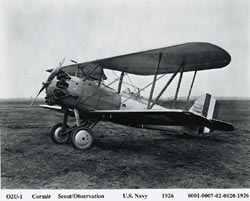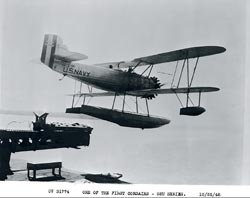|
 The Navy issued specifications in 1925 for a rugged new observation airplane. Chance Vought Corporation submitted plans that won a contract for two prototypes. Nicknamed the “Corsair,” it was the first service airplane designed around the new Pratt & Whitney Aircraft “Wasp,” air-cooled engine. The Wasp, rated initially at 410-hp, was the first reliable air-cooled radial to match the power of the existing water-cooled Liberty and Curtiss Hispano engines. The Vought Corsair, eventually proved to be one of the most useful and versatile military airplanes ever produced. The new biplane, designated by the Navy as the O2U-1, proved to be all that was desired, and more. This new Vought airplane was one of the first to have an all-steel-tube fuselage. Features of the earlier Vought designs which were retained included the cheek tank and the method of fuselage streamlining. First delivered in 1926, the new Corsair, although dubbed an observation machine, quickly proved itself equally adroit in many roles. Convertible to either fixed gear, amphibian, or float-plane, it won immediate favor with the fleet and resulted in numerous government contracts for additional deliveries. In short order, the Corsair set four world altitude and speed records and gained such international prominence that foreign governments began placing orders. The Navy issued specifications in 1925 for a rugged new observation airplane. Chance Vought Corporation submitted plans that won a contract for two prototypes. Nicknamed the “Corsair,” it was the first service airplane designed around the new Pratt & Whitney Aircraft “Wasp,” air-cooled engine. The Wasp, rated initially at 410-hp, was the first reliable air-cooled radial to match the power of the existing water-cooled Liberty and Curtiss Hispano engines. The Vought Corsair, eventually proved to be one of the most useful and versatile military airplanes ever produced. The new biplane, designated by the Navy as the O2U-1, proved to be all that was desired, and more. This new Vought airplane was one of the first to have an all-steel-tube fuselage. Features of the earlier Vought designs which were retained included the cheek tank and the method of fuselage streamlining. First delivered in 1926, the new Corsair, although dubbed an observation machine, quickly proved itself equally adroit in many roles. Convertible to either fixed gear, amphibian, or float-plane, it won immediate favor with the fleet and resulted in numerous government contracts for additional deliveries. In short order, the Corsair set four world altitude and speed records and gained such international prominence that foreign governments began placing orders.
With deliveries beginning in December 1927, the O2U Corsair went into immediate service with the Navy and the Marine Corps. In the 1928 Nicaraguan campaign, Marine Corsairs earned further distinctions by being the first planes ever to conduct an unsupported attack against fortified positions. Attacking a force of 1,500 rebels, four Corsairs began low-level strafing and light bombing against well armed positions. In this campaign, Lt. Frank Schilt, USMC, won the Medal of Honor while flying the Corsair.
 Using the new Pratt & Whitney 425-hp, air-cooled engine, the Corsair’s tactical flexibility rapidly earned it the reputation as a jack-of-all-trades. They could be flown on wheels from an aircraft carrier as a defensive fighter, catapulted as an amphibian from battleships and cruisers, and land on carriers for re-servicing. For strictly water use, the amphibian landing wheels that Chance Vought designed could easily be removed and stored. Using the new Pratt & Whitney 425-hp, air-cooled engine, the Corsair’s tactical flexibility rapidly earned it the reputation as a jack-of-all-trades. They could be flown on wheels from an aircraft carrier as a defensive fighter, catapulted as an amphibian from battleships and cruisers, and land on carriers for re-servicing. For strictly water use, the amphibian landing wheels that Chance Vought designed could easily be removed and stored.
|